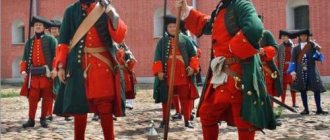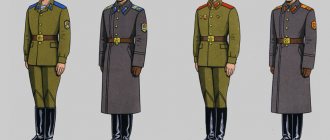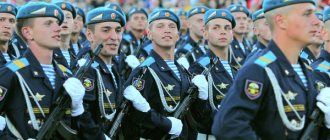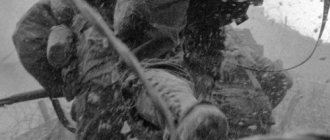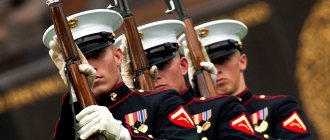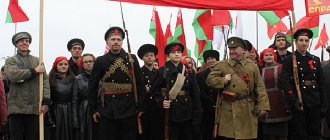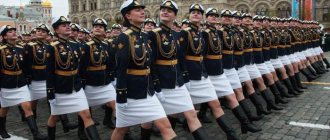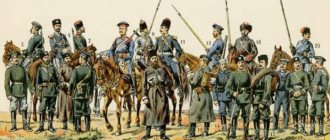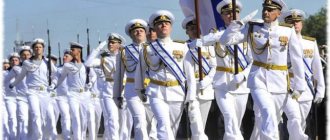- August 28, 2018
- Civil law
- Anastasia Klimenkova
Military uniform is the key to good combat effectiveness of the army. In the Russian Federation, uniforms are currently used that meet the necessary key requirements: reliable, comfortable and performing the functions assigned to it. According to the innovations of 2022, in addition to the description of the new military uniform and insignia, requirements for wearing it have been introduced, which are mandatory for a soldier of any rank.
Dress uniform of the Russian army: history
Wearing a military uniform, which includes historically established attributes and worn for special occasions, has developed in the army traditions of all states, including Russia.
At the same time, the modern Russian ceremonial military uniform of the Russian Army (RA) and Navy (Navy) combines the traditions of eras completely different in spirit and style: the Russian Empire, the Soviet Union and modern state and military paraphernalia. Since the formation of the Russian Empire, the special military uniform introduced by Peter the Great reflected his desire to reform the army along the lines of the advanced countries of that time. The elements and details of such ammunition (shoes, belts, cartridge bags, hats) were unified and were predominantly of a utilitarian nature, in demand in real use in campaigns and battles.
The cut of the officer's uniform was similar to that of the soldier's, but was trimmed with gold braid and gilded buttons. The main symbol of belonging to the officer corps was a special scarf, as well as a plume on a hat made of white and red feathers. One of the main attributes of the dress uniform of the Russian army was powdered wigs, which existed as a mandatory accessory until the reign of Alexander I.
The era of the Napoleonic wars and mass armies permanently changed the appearance of the military uniform of all armies towards simplification. This process fully affected the Russian army: during the 19th century, with the exception of certain “ceremonial” regiments, the dress uniform of officers and soldiers became more functional: “tailcoat” uniforms disappeared, and sewing was reduced. Under Alexander III, the military uniform was seriously unified, at the same time receiving a characteristic “national” look: wide trousers tucked into high boots; lamb ceremonial hats, etc. Long-range, rapid-fire weapons have forever done away with the multi-colored uniforms, bringing ceremonial versions of military uniforms closer to everyday ones.
After the revolution of 1917, all previous military ranks and titles in Soviet Russia were abolished, and in the soon created Workers' and Peasants' Red Army (RKKA), a special dress uniform was present mainly for the circle of senior command personnel. In addition, in the mid-1930s, in order to increase the prestige of service in aviation and tank forces, their personnel were approved for their own versions of dress and casual uniforms, differing from the general army in color and style.
The wearing of dress uniforms in the Red Army was not regulated until 1940, when the ranks of general and admiral were introduced, which finally completed the formation of a new system of military ranks, which has generally been preserved to the present day. In 1941-1942, it was planned to equip all Red Army personnel with ceremonial military uniforms, but with the beginning of the Great Patriotic War, these plans were curtailed.
The supply of clothing to all categories of military personnel in full dress uniform in the USSR was fully developed only in the post-war period. At the same time, two separate types of such uniforms were provided for the officers of the Soviet Army (as well as border and internal troops) - ceremonial and ceremonial-weekend, and each of them had winter and summer versions. The configuration of the Soviet ceremonial military uniform changed quite often; traditional stand-up collars and riding breeches gradually became a thing of the past.
The most characteristic appearance of the ceremonial military uniform is considered to be the one established in 1968. For privates and sergeants of the Soviet Army, the dress uniform was khaki and included:
- Open uniform;
- Long sleeve shirt and tie;
- Trousers;
- A cap with a colored band and a cockade;
- Leather belt with stamped buckle.
In winter, soldiers and sergeants wore a single-breasted overcoat and a hat with earflaps, which were included in both dress and everyday clothing. On the overcoat, as well as on the ceremonial jacket, shoulder straps with the letters “SA”, buttonholes and a sleeve chevron in colors established for specific types of the Armed Forces and branches of the military were sewn on.
The dress uniform of the Airborne Forces (Airborne Forces) required wearing a blue beret and a vest under the jacket. The basis of the officer's ceremonial uniform was the single-breasted jacket, and the rank of the senior command staff was emphasized by stripes on the trousers and gold embroidery on the uniforms and caps.
The dress uniform in the Armed Forces of the Russian Federation (RF Armed Forces) is worn strictly in accordance with the Rules for wearing military uniforms by military personnel, which are approved by order of the Russian Minister of Defense. At the same time, the continuity in the design of ceremonial uniforms with the Soviet military uniform in the first years of the existence of the RF Armed Forces was preserved almost completely, reflecting the changes that occurred with the collapse of the USSR only in the change of sleeve patches, as well as the replacement of the letters “SA” with “VS” on the shoulder straps of the ceremonial uniform of privates and junior command staff.
Headdresses in the Russian Army, on the contrary, have undergone significant changes since 1992. New cockades were introduced for all categories of military personnel (later changed more than once). In the winter version of the dress uniform of generals and colonels, hats were replaced with gray earflap hats. For the ceremonial uniform of conscripts, caps (as well as berets for female military personnel) were replaced by officer-style caps.
At the same time, the traditional division of the basic color of the officer’s uniform by branch of the Armed Forces was preserved: black and white for the Navy, blue for aviation, and sea green for the ceremonial uniform of the ground forces. However, in the period from 1994 to 2010 they tried to replace the last option (as well as the steel-gray general’s uniform) with a slightly modified olive shade of the same basic color, but in the end everything returned to the previous version. The ceremonial shoulder straps on the jackets of army conscripts and contract soldiers became a single protective color.
Subsequent changes occurred, as a rule, as the army's stocks of Soviet military uniforms, which had been accumulated in significant volumes, wore out. Instead of the ceremonial uniform and everyday jacket, a unified single-breasted French jacket without piping with patch pockets and buttons on the flaps, with sewn shoulder straps, was introduced for all military personnel.
The introduction of the new dress uniform of the Russian Army, in the development of which the famous fashion designer Valentin Yudashkin took part, after 2010 was supposed to be quite gradual and multi-year. The fundamental document regulating the procedure for wearing military uniforms by Russian military personnel was Order of the Minister of Defense of the Russian Federation dated June 22, 2015 No. 300 “On approval of the Rules for wearing military uniforms, insignia, departmental insignia and other heraldic signs in the Armed Forces of the Russian Federation and Order mixing items of existing and new military uniforms in the Armed Forces of the Russian Federation", with certain amendments, valid to this day.
What applies to clothing provision?
Once a serviceman enters service in the Russian army, he is paid by the state. Upon arrival at the military unit, they receive the necessary set of everyday uniforms. For viewings and festive events, dress uniforms are provided. You cannot do without bed linen and personal hygiene items during your service.
Military units require certain types of sports and mountaineering equipment to perform their duties. The list of clothing supplies is regulated by Government Decree No. 390 of June 22, 2006 and Federal Law No. 76 of 1998. All categories of military personnel receive uniforms, linen and hygiene items.
The government document sets out in detail the security standards:
- warrant officers and officers;
- soldiers, sergeants and foremen of conscript service and under contract;
- foremen and sailors;
- officers and midshipmen of the Navy;
- Coast Guard personnel;
- aviation flight and technical personnel;
- female military personnel;
- cadets of military secondary and higher vocational educational institutions.
The resolution is provided with tables indicating nomenclature units and the amount of property allocated to one serviceman. In addition, the service life of each item is specified there.
Often senior ranks teach recruits how to properly handle the clothes they receive.
Legislative regulation of the issue
The rules for wearing military uniforms, as well as all issues related to military personnel in general, are regulated by the following legal regulations:
- Constitution of the Russian Federation. Article 59 establishes the obligation of every Russian citizen to perform military service in accordance with federal legislation.
- Federal Law No. 53 of March 28, 1998, regulating issues of military service and the essence of military duty.
- Decree of the President of the Russian Federation No. 293 of March 11, 2010, defining the features of military uniforms, insignia for military personnel and departmental insignia.
- Order of the Russian Minister of Defense No. 300 of June 22, 2015, which approved the Rules for wearing special military uniforms.
Global reform of the Russian army uniform
The modern history of Russia includes several unsuccessful attempts to change military uniforms. While our country was spending huge amounts of money on unsuccessful experiments, in the US Army, military clothing became more comfortable, its performance characteristics increased, and innovative materials were used in the production of clothing.
The modern military uniform began its journey in 2007, when the post of Minister of Defense was held by Anatoly Serdyukov. It was then that a large-scale sketch competition was organized, in which thousands of designers from all over the country took part. The Ministry of Defense awarded the victory to the famous designer Valentin Yudashkin.
For the next two years, specialists were developing the final versions of a new army uniform, intended for further equipment of the Russian Army. The result was a set of clothing that was in many ways similar to American uniforms. The developers did not agree with this opinion, although many factors spoke in favor of this comparison.
The winter military uniform caused particular dissatisfaction. It did not protect the soldiers from the cold. For this reason, the Ministry of Defense received many complaints every day about the poor quality of the winter kit. This led to an outbreak of colds among the military. There were also complaints about the appearance of the uniform: some stylistic solutions were copied from kits in other countries. The stumbling block was the quality of the fabric and thread: new military clothing quickly became unusable.
Negative reviews and dissatisfaction among soldiers and army specialists forced the Ministry of Defense to think about changing the equipment. The decision to take American clothing as a basis was a mistake; such costumes were not suitable for the conditions of our country. The new set of military uniforms, developed subsequently, consisted of 19 parts. The approximate cost of one set is 35 thousand rubles. The ceremonial version did not suffer any special changes, since the field uniform is of particular importance.
History of the police
The first organization of police forces resembling today's law enforcement services was founded almost two hundred years ago, namely in 1829. Its creator, Robert Peel, issued the Metropolitan Police Act, a document that was used to form the first properly trained police force. Then everyone saw the first officers in blue uniforms. Why was this particular color chosen?
New field military uniform of the Russian Armed Forces
The first change that caught my eye was the change in the location of the shoulder straps on the uniform. In 2010, a “NATO” version was proposed, the shoulder straps in it were located on the “belly”. Many servicemen did not like this, since they were “used to seeing shoulder straps on their shoulders.” The chevrons on the uniform are located on both sleeves. An addition was the appearance of fitted overcoats, quickly secured clothing items with Velcro. For the first time in history, Russian officers received warm sweaters. It was not possible to completely replace foot wraps and boots.
Valentin Yudashkin was blamed for the failed project of a new military suit. In 2012, he spoke to reporters and stated that the clothes he used were very different from his version. In particular, to reduce costs, materials were replaced with lower quality ones. Journalists came to the conclusion that all that remained of the designer’s version was the appearance.
The new generation of military uniforms was developed based on feedback from thousands of soldiers from across the country. The shape of the aircraft has become multi-layered. This allows each soldier to independently choose the necessary items of clothing, guided by the goals and objectives assigned to him, as well as weather conditions.
The modified VKPO set includes a basic suit, several types of jackets, boots for different seasons and much more, including a balaclava, a synthetic belt and high-quality socks. Military uniforms are made from mixed fabric, which includes 65% cotton and 35% polymer materials.
Every soldier had new-style Russian military clothing at the end of 2022, as previously planned by the Ministry of Defense. The change of equipment took place in three stages. In 2013, 100 thousand new kits were issued, in 2014 - 400 thousand and in 2022 - 500 thousand. In 3 years, a million military personnel were provided.
The complete rejection of foot wraps deserves special attention. Modern images of military uniforms include 12 pairs of socks for one soldier, which he uses throughout the year. It is planned to soon increase the number of pairs per military man to 24.
VKPO kits for wearing at different atmospheric temperatures
The new model military uniform is presented in two sets:
- Basic uniform for wearing at temperatures above +15 degrees Celsius;
- Multi-layer system for wearing in temperatures from +15 to -40 degrees Celsius.
In winter, soldiers wear lightweight or fleece underwear sets. They are selected depending on the air temperature. In particularly cold areas, both sets of underwear can be worn one on top of the other.
For equipment in the summer, trousers, a jacket, a beret and boots are used. The surface of the clothing is carefully treated with an innovative solution that repels moisture. It allows clothes to remain dry in the rain for up to two hours. To protect against mechanical influences, military clothing is equipped with reinforcing elements. Such kits are used in parts with a high degree of load.
The rules for wearing military uniforms allow you to use a fleece jacket in the autumn season: excellent thermal insulation is provided by the pile with which it is covered on both sides. A windbreaker jacket, worn with fifth-layer trousers, protects from strong winds.
A demi-season military suit is intended for the autumn period. The material from which it is made provides reliable protection from the wind, a good degree of vapor permeability and dries quickly after getting wet. During heavy rainfalls, it is permissible to use a wind and water protection kit. The membrane and reliable sizing of the layers provide reliable protection from moisture.
Modern ceremonial military uniform of the Russian Armed Forces
The basic design of the dress uniform has not changed for many years, as it continues to meet modern requirements while paying tribute to history. Only a few elements have been replaced in recent years due to their obsolescence. The dress uniform is worn at parades, holidays, when receiving military awards, etc.
In the Russian army there are three approaches to the formation of such a set of uniforms:
- Traditional. Clothing sets include elements created back in the 19th century. A good example is the ceremonial outfit of the Presidential Regiment of the Russian Federation - their costumes are identical to the uniform of the Imperial Guard, adopted in 1907;
- Modern. The cut of the dress uniform corresponds to the daily set; the same colors can be used. For example, in the Armed Forces of the Russian Federation, the color of the ceremonial jacket coincides with the everyday one. Casual elements are complemented by ceremonial elements;
- Universal. The color of a ceremonial suit can be the same as the everyday one, but the colors of the ceremonial elements must be different.
The dress uniform must strictly meet the following standards:
- The style of the military uniform of military personnel of the Russian Army must be observed;
- A military suit for ceremonial purposes should be strict and elegant;
- Only high-quality materials should be used in production.
Changes to the design of the dress uniform are rarely made; its main style is determined by history. Various additional elements may change each year. Changing the materials used in production is permissible only if it improves the quality and performance characteristics of the suit.
The general's ceremonial outfit deserves attention. It is also similar to a casual suit, but has a difference in color. The color of the dress uniform is gray, worn with bluish trousers and black boots. There are stripes on the collar and cuffs.
Peter I
After centuries of dominance of traditional Russian clothing, Peter I made a decisive break with the past and introduced European costume in the French style. The military uniform of that time was similar to civilian clothing, differing only in unified colors and special decoration.
Private, sergeant and officer of the Life Guards Regiment under Peter I (photo source)
Ordinary townspeople and soldiers looked almost the same: a knee-length caftan, widening from the waist down, its sleeves decorated with large cuffs; under the caftan they wore a short jacket - a camisole, and on their legs short culottes to the knee and stockings with shoes. They wore a triangular hat and a wig, which was sometimes replaced with their own long hair.
Despite the pretentiousness of the outfit, it was very comfortable and did not cause serious inconvenience.
The caftan sat loosely on the body; in warm weather it was unbuttoned - or buttoned when it became cooler. The only questions that raise questions are the wide cuffs: they are beautiful, but not too utilitarian. The tricorne hat is comfortable - it is no coincidence that this hat had such a long life. Short pants with stockings are somewhat unusual, but you quickly get used to them. As for the wig, in my opinion, at the beginning of the 18th century it was too massive.
Wearing comfort: 3.5
Headquarters uniform
Office clothing for those who work in ministerial offices of the Armed Forces consists of:
- soft green cap or beret;
- shirts without a tie with Velcro shoulder straps;
- white T-shirt under the shirt;
- trousers
In cold weather, it is recommended to wear a warm jacket with a hood and a hat with earflaps. Shoulder straps are attached to the shoulders of the suit. Although the office uniform is an everyday uniform, it is not allowed to be used in the field.
Emblems and flags of the Organization of Russia
All Customs Army
Air ForceVMFVDVEducationFSBFSOGIBDDMChSMinistriesMVDOSecurityPolitical partiesTaxesTransport| List | Flags | Coats of arms |
Visual search for flags Similar coats of arms Similar flags Colors of flags World Countries Countries of the Schengen zone Unrecognized states Non-existent countries Capitals States, provinces ... Cities of the world USA States USA Districts of the USA State capitals USA cities Russia Regions, territories Regional centers Districts of Russia Cities of Russia Organizations, symbols International organizations Organizations Russia Symbols of Tsarist Russia, USSR, orders, medals| Submit an articleNewsletterAbout us Mail | Graphics FontsLogosBrandbooksPictogramsHeraldics | Popular Site levelSite registrationHow to make a website1st place on GoogleTranslators OnlinePassword Top Internet |
Ph4 in social networks, mailings and contact
2005-2020, Web studio Ph4 - Internet catalog for users, webmasters and designers
Color Differences
The color design of the military uniform depends on the branch of the army:
- Navy recruits wear dark blue uniforms. The color white is present in clothing, especially for summer clothing. This is due to hot weather, because white color better reflects ultraviolet rays.
- Ground forces wear green uniforms. The shade of the material on formal clothing changes. It is closer to the color of sea green.
- The blue shade of clothing is typical for flight personnel serving the Military Space Forces.
The cap badges also differ in color. The infantrymen have a golden cockade with a red band. In the space forces - blue, in the artillery, rocket and tank crews - black. The emblem of the military branch is placed on the crown of the caps. It is made of metal with gold plating. Ceremonial hats and everyday caps are made of blue material for military personnel of the Aerospace Forces, and black for the Navy.
Shoulder straps and insignia on clothing
For officers, both senior and lower ranks, it is mandatory to attach removable shoulder straps to the shoulders. They are attached to summer and winter clothes. Wearing shoulder straps is mandatory for cadets of military schools.
The shoulder straps must have rank insignia. For senior officers - stars, petty officers, sergeants, corporals - stripes. They are located longitudinally along the entire length of the shoulder straps and transversely. There are lapel and sleeve insignia of belonging to the military branches on the clothes.
The field uniform is decorated with stripes on the chest on the right - Russian Armed Forces, on the left - the surname and initials of the serviceman. The color of the edging of the patches depends on the type of troops. So, for VKS it is blue. The procedure for wearing honorary badges and medals on clothing is determined by order of the Ministry of Defense of the Russian Federation.
Chevrons of the military branches
The chevrons of the military branches allow you to determine who is in front of you: a sailor or an infantryman, a missileman or a paratrooper. We remind you that we can embroider any chevrons of the military branches.
These chevrons and stripes of the Russian Army are worn on the right sleeve.
| Ground troops . Golden flaming grenada against the background of two crossed swords. Burning Grenada is a fighting force. Swords are a symbol of armed struggle. For more details, see the article about infantry chevrons . | |
| Signal Corps . Golden vertical lightning bolts, three up, three down, against the background of outstretched wings. Lightning is a historical symbol of the Signal Corps. A variety of types of communication and the ability to transmit information at lightning speed. Wings are a symbol of speed and speed. | |
| Radiation, chemical and biological defense troops . An outline gold regular hexagon with three diverging rays of gold color, in the lower part there are four intersecting red rings. | |
| Rocket Forces and Artillery . Two golden crossed gun barrels. The guns are a historical symbol of artillery. These chevrons symbolize the continuity of military traditions. | |
| Military air defense . Three golden crossed arrows intersect with the barrel of an anti-aircraft gun. The arrow is a symbol of determination and inflexibility. This is a purposeful order of air defense activities. An anti-aircraft gun is a symbol of strength, valor and courage. | |
| Air Force . A silver propeller intersects with an anti-aircraft gun against a backdrop of silver soaring wings. | |
| Navy . A golden double-headed eagle with outstretched wings, holding in its paws two silver Admiralty anchors crossed behind its back. These chevrons of the Russian army are usually made on black cloth. | |
| Strategic Missile Forces . A golden round shield with an ornament and eight rivets on a golden sword and diagonally crossed arrows. | |
| Airborne troops . Golden flaming grenade with wings. | |
| Space Forces . A stylized contour image of a launching space rocket against the background of a stylized globe with a tricolor. The rocket symbolizes our achievements in space exploration. Dark blue means the Universe, white space, blue means air, red means Earth. Our rocket takes off from the Earth and opens the Universe through the air through space. These are the youngest chevrons of the Russian troops. |
New dress uniform for military personnel
Military personnel of the Russian Armed Forces wear full dress uniform:
- When participating in parades and official events with the participation of troops (forces);
- On holidays of the military unit;
- Upon receipt of state awards;
- When presenting a military unit with the Battle Banner;
- When launching a ship entering service, when raising the Naval flag on the ship;
- When appointed to the honor guard;
- When serving as sentries to protect the Battle Banner of a military unit.
In addition, military personnel are allowed to wear full military uniform on weekends, during off-duty periods.
From the officers
The new dress uniform for officers of the Russian Army was first presented on May 9, 2022 during the parade on Red Square in Moscow. Its main feature is a closed, single-breasted, sea-green colored uniform (for officials of the Ministry of Defense with the highest class ranks - gray (with a silver device); for the dress uniform of generals and officers of the Aerospace Forces - blue), on six gilded coat of arms buttons, with piping board, collar and cuffs.
Purpose of strategic missile forces
The main weapons of the Strategic Missile Forces are intercontinental ballistic missiles (abbreviated as ICBMs) with nuclear warheads, which are capable of hitting a target anywhere on our planet. They come in two types:
- mine;
- mobile.
The main purpose of the Strategic Missile Forces is to contain a nuclear conflict and eliminate possible aggression. They can carry out their tasks as part of the strategic nuclear forces of the Russian Federation or in separate (mass, group, single) nuclear missile strikes against the enemy’s strategic targets that make up its military or military-economic potential.
In peacetime, the Strategic Missile Forces perform the task of deterring large-scale aggression from potential adversaries. The implementation of this goal includes the following activities:
- combat duty;
- demonstration actions;
- demonstration and strike actions.
In the event of a nuclear missile war, the Strategic Missile Forces are capable of destroying important enemy targets in a given strategic direction.
Equipment and appearance of office uniforms for military personnel of the Russian Armed Forces
The office set includes a shirt, jacket, and trousers of a classic cut. The difference in costumes by gender lies in the addition of a straight-cut skirt for female military personnel.
Uniform of military personnel of the Russian Armed Forces for wearing in the office (men's and women's suits)
The set of summer uniforms for women with a military rank includes:
- khaki cap (for Army servicemen) made of woolen fabric;
- a casual hat, in color corresponding to the uniform;
- blouse and shirt with short sleeves;
- blouse and long sleeve shirt;
- a strict skirt made of plain-dyed cotton-polyester fabric;
- wool trousers;
- suit jacket with short sleeves;
- suit jacket with long sleeves;
- tie;
- black shoes made of genuine leather with stable heels (333 Type B);
- flesh-colored tights.
Additional information about the new office uniform in the army
According to the Order of the Ministry of Defense, wearing uniforms, departmental and heraldic insignia is an obligation not only for military personnel, but also for federal government civilians working in military departments and departments, the General Staff, and the Ministry.
The new uniform is identical for military personnel and civilian personnel of the Russian Armed Forces in terms of cut and quality of fabric used. Distinctive features are insignia: army shoulder straps, buttonholes and other chevrons, heraldic insignia for federal government civil servants.
Sleeve insignia for civil servants correspond to a specific department (department), and are placed on the right sleeve of a jacket or shirt. Breast badges for civil servants reflect: the right-sided ones - belonging to the Armed Forces, have the inscription “Ministry of Defense of Russia”, the left-sided ones - the surname and initials.
For civilian personnel with a class rank, the uniform is distinguished by the silver (gray-white) color of the device, for military personnel - the gold (yellow) color of the device. Civil servants of the RF Armed Forces with the rank of State Counselor are required to wear shoulder straps on their jackets, winter uniforms and shirts.
The location and appearance of buttonholes on the office uniform of ground forces officers
Improvements to police uniforms in Russia
In 2011, in Russia it was decided to change the appearance of the police uniform, because the old model had already gone out of fashion and began to seem undignified and unprofessional. This even applied to riot police.
Names must be unusual: Polar bear cubs are asked to come up with names
Windows 10: Improved privacy and other new features in Windows update
Morgenstern will work on the album with the American studio Atlantic Records
Winter and summer dress uniform
The global reform did not affect the main concept of uniforms for special occasions. The changes affected obsolete elements.
Ceremonial uniforms are intended for celebrations. In Russia, she uses three types of military clothing for special occasions:
- Traditional, created in the last century. For example, the Presidential Regiment of the Russian Federation wears the uniform adopted at the beginning of the 20th century.
- Modern, suitable for everyday wear, complemented by festive elements.
- Universal. In such equipment, the colors of the ceremonial elements differ from the colors of everyday uniforms.
There are also differences between the uniform of the honor guard and all other military formations.
What elements does summer clothing for special occasions consist of:
- Cap made of natural wool with a band. For higher ranks, sewing should be used.
- Ceremonial uniform with shoulder straps and buttonholes. For senior officers, sewing is used.
- Trousers made of natural wool fabric. The senior staff wears stripes.
- Dress uniform for military officials, or uniform.
- Snow white shirt.
- Ceremonial exit belt.
- Black tie and brass bartack.
- Low shoes/chrome boots.
- White kid gloves.
Winter ceremonial costume includes:
- Fur gray earflaps. For senior staff - from astrakhan.
- Dress-up coat.
- Demi-season or winter boots/low shoes.
- All items of clothing are flight version, except for the cap.
Basic requirements for a formal uniform: compliance with historical style, rigor, elegance, high-quality materials.
The general's uniform has a special color scheme. The exit uniform should be gray, trousers - blue, shoes - black. The stripes are located on the collar and cuffs.

